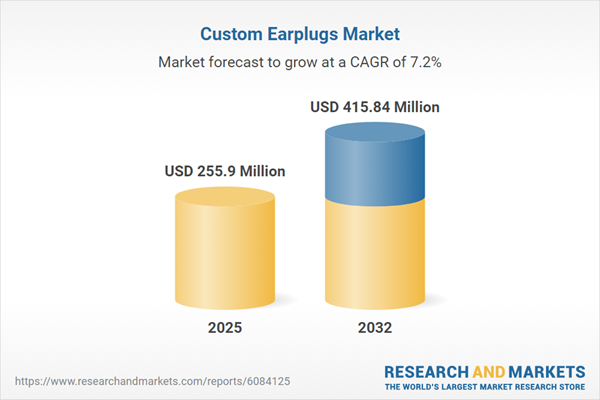Speak directly to the analyst to clarify any post sales queries you may have.
The custom earplugs market is evolving rapidly, driven by developments in hearing health awareness, technological innovation, and changing regulatory standards. Senior leaders are seeking solutions that deliver tailored protection and performance across diverse professional and personal environments.
Market Snapshot: Custom Earplugs Market Growth and Opportunity
The custom earplugs market grew from USD 238.53 million in 2024 to USD 255.90 million in 2025, with projected expansion at a CAGR of 7.19%, reaching USD 415.84 million by 2032. This growth reflects heightened engagement across industries prioritizing hearing conservation, regulatory compliance, and the adoption of advanced fitting technologies. The sector has become a focal point for organizations aiming to ensure workforce safety and elevate wellness outcomes, particularly in industrial, medical, and recreational environments.
Scope & Segmentation
The report provides comprehensive analysis and actionable segmentation across several core categories, enabling targeted strategic planning for stakeholders:
- Technology: Active electronic solutions, level dependent attenuation, and passive protection approaches.
- Distribution Channel: Offline retail via general and specialty stores, as well as online retail channels including brand websites and digital marketplaces.
- Price Range: Low-cost, mid-tier, and premium offerings tailored to diverse buyer preferences.
- Material: Options including acrylic, foam, silicone, and wax for custom molding and enhanced comfort.
- Application: Utilized in industrial (construction, manufacturing, oil and gas), medical (diagnostic, assessment, rehabilitation), military, music (live, studio, monitoring), and recreational (motorcycling, shooting, swimming) contexts.
- Geographies: Americas (North, Central, and Latin America), Europe, Middle East and Africa, and Asia-Pacific, each presenting unique dynamics shaped by local regulations, market maturity, and consumer drivers.
Key Takeaways for Senior Decision-Makers
- Regulatory shifts in occupational health and public safety are fueling demand for bespoke hearing protection in sectors like construction, manufacturing, and energy.
- Digitally enabled ear scanning, additive manufacturing, and integrated electronic features set new industry standards for fit, comfort, and usability.
- Growth in direct-to-consumer sales and online audiology platforms is transforming engagement, reducing reliance on in-person clinical services, and driving omnichannel strategy.
- Innovations in material science, such as hypoallergenic and sustainable options, expand the market's appeal across sensitive demographics and sustainability-focused buyers.
- Market fragmentation is creating ongoing opportunities for partnerships between audiologists, technology leaders, and retail providers focused on end-to-end user experiences.
- Localized production in response to regulatory or trade measures is helping manufacturers optimize supply chain resilience and improve service levels regionally.
Tariff Impact: Navigating New Trade Pressures
With new tariffs scheduled by 2025 in the United States, global supply chains for custom earplugs are adjusting sourcing and manufacturing strategies. Domestic players are intensifying local procurement, while international brands are investing in U.S.-based facilities to bypass cost escalations. Meanwhile, smaller workshops may pursue consolidation or partnerships to offset additional expenses and maintain competitive pricing. Strategic communication of product value is becoming essential as buyers assess increased costs against the benefits of advanced custom earplug solutions.
Market Research Methodology & Data Sources
This report is built on a multi-source approach combining primary interviews with industry stakeholders and extensive secondary data review. Key insights are validated through structured interviews with executives, audiology professionals, and supply chain partners, complemented by analysis of regulatory filings, patent literature, and trade association research. Rigorous statistical reconciliation and expert review ensure findings are robust and actionable.
Why This Report Matters
- Gain a strategic view of evolving market forces and regulatory requirements shaping custom earplug adoption in core industries and verticals.
- Access in-depth segmentation and region-specific insights to guide product development, investment, and partnership strategies.
- Use validated market data and trend analysis for confident, long-term planning in sourcing, production, and commercial operations.
Conclusion
The custom earplug market is on a trajectory defined by regulatory evolution, digital transformation, and rising attention to hearing health outcomes. Stakeholders equipped with data-driven insights and adaptive strategies will be best positioned to realize sustainable growth and meet new user expectations in this expanding segment.
Table of Contents
3. Executive Summary
4. Market Overview
7. Cumulative Impact of Artificial Intelligence 2025
Companies Mentioned
The companies profiled in this Custom Earplugs market report include:- 3M Company
- Honeywell International Inc.
- Moldex-Metric, Inc.
- Westone Laboratories, Inc.
- Etymotic Research, Inc.
- Sensaphonics Hearing Conservation LLC
- ACS Custom, Inc.
- Future Sonics, Inc.
- Alpine Hearing Protection GmbH
- Decibullz, LLC
Table Information
| Report Attribute | Details |
|---|---|
| No. of Pages | 184 |
| Published | November 2025 |
| Forecast Period | 2025 - 2032 |
| Estimated Market Value ( USD | $ 255.9 Million |
| Forecasted Market Value ( USD | $ 415.84 Million |
| Compound Annual Growth Rate | 7.1% |
| Regions Covered | Global |
| No. of Companies Mentioned | 11 |









